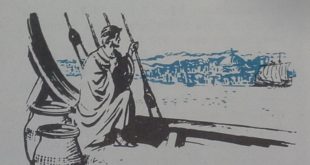Christianity was the movement that spread Across the Roman Empire Pointing the way for the rest of the ancient world toward belief in a single God. The year is 400 A.D. Andropolos paces impatiently up and down the deck of the merchant ship. He is eager to get back home; and to Andropolos, home is the city of Constantinople, a new capital of the Roman Empire. He can already see the walls and buildings of the great city shimmering in the distance. Now the ship is nearing the narrow Bosporus, the waterway where Europe and Asia are hardly a mile …
Read More »Tag Archives: St. Sophia
Byzantium and Russia 400 B. C. – 1240 A. D.
THE BEGINNINGS of Russian history date back to the centuries when Byzantium was at the height of its glory. A thousand years before that Herodotus, the Greek explorer, found Greek settlements on the northern shore of the Black Sea. They traded with the Scythians, a tribe of nomads living on the open plains that stretched eastward for thousands of miles to the mountains of Asia. Bordering these plains on the north were the forest lands and above them, in the far north, stretched the frozen wastes of the arctic tundra. In all that vast land there were no barriers, no …
Read More »
